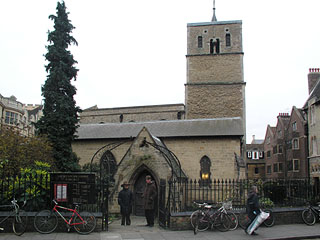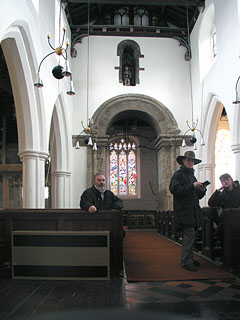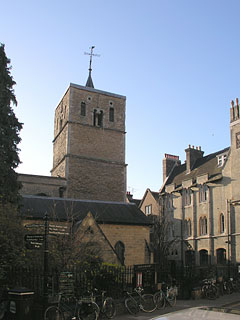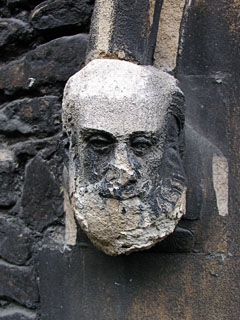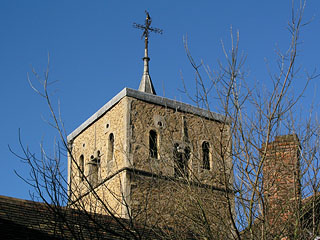The Anglo-Saxon tower of St Bene't is the oldest building in Cambridge - in fact, it's the oldest in the county. Magnificent it is, too, rising out of its somewhat sunken churchyard. It gets gradually narrower as it gets higher, and the long-and-short work is easily visible all the way up. There will have been grander churches in Cambridge even at the time that St Bene't was built, of course, but it's sobering to think that this building pre-dates the university by two centuries and that it was older when Great St Mary's was built than Great St Mary's is now. It's generally accepted that the tower was built some time between 1000 and 1050.
This is particularly obvious when you go inside. Before you do though pop round the corner if you can, and have a look at the lovely little garden on the south side of the church. The space is almost entirely enclosed by the church and the dark red brick of Corpus Christi College, and in summer it's a lovely place, scented strongly with rosemary.
Inside the church, though, there isn't much to see but the tower arch. The nave arcades and roof are Perpendicular, but not terribly exciting, and most of the rest of the church was rebuilt by the Victorians, so don't get distracted, even by the ghastly angels in the north aisle that look like second-hand ship figureheads. Aside from its one treasure, St Bene't isn't terribly exciting, and I've always found it rather dark and unwelcoming. [Mark adds: I think this is the effect of the age and consequently rather sunken position of the church - it's loomed over by a lot of grim victorian gothickery. The nave, in true anglican tradition, has a good example of those light fittings that are vaguely reminiscent of a sixties sci-fi film - War of the Worlds perhaps...]
The tower arch, though, is a splendid thing, and more than makes up for the rest of the church. It's surprisingly big, given how slight the tower seems from outside. Slightly squiffy engaged columns reach up to a decidedly squiffy moulded cornice, which continues along the east face of the tower on either side of the arch. On top of this sit two strange animals (Pevsner calls them 'barbaric beasts' - the RCHM rather adventurously labels them lions), and from these spring the arch itself. The whole ensemble is a remarkable piece of syncretism. We have very traditional Anglo-Saxon construction of long-and-short work, which is surrounded by a valiant attempt at copying the sort of Romanesque columns and decoration that was common on the continent at the same time. As Pevsner observes, it doesn't quite work - it looks as though the masons have seen engaged columns and cornices without understanding what they do. Why else have cornices of that sort and animals from which the arch springs? The carving is very good quality, but there aren't many straight lines to be seen, particularly on the horizontal. It's awkward and very endearing. Why do we have this strange mingling of styles, then? The answer might be something to do with what was going on in the world at the time that St Bene't was built.
11th century England was a turbulent place. At the millennium Aethelred Unraed ('the Unready', by corruption) was king. He had become king in 978 when his mother had his half-brother Edward murdered at Corfe Castle in Dorset. Edward, as often happens to murdered kings, became revered as a martyr and was canonised - there's a church dedicated to him just round the corner from St Bene't, as it happens ( St Edward King and Martyr, on an alleyway between Peas Hill and King's Parade).
After such an unsavoury start, Aethelred's reign was rather unfortunate. He was famed for ruling badly ('Unraed' refers to the ill counsel he received from his favourites), and in 1013 Sweyn Forkbeard of Norway came to England, desirous of possessing the throne. Aethelred fled to France, leaving the throne to Sweyn, though in the event Sweyn died a few weeks later and Aethelred was able to return to reign in London until his death in 1016.
Aethelred's son Edmund (Ironside) was acclaimed King by the folk of London, which he was defending at that time against Knut, son of Sweyn. Knut, though, was acclaimed king by the Anglo-Saxon Witan. After much battling and hacking of limbs, they decided to split England between them, with the lands of whoever died first going to the survivor. In the event, Edmund died a few months later, and Knut reigned for another 19 years, and married Aethelred's widow Emma. His sons Harald Harefoot and Harthaknut succeeded, before the latter died of convulsions brought on by overmuch quaffing. He was succeeded by his half-brother Edward, who was the eldest son of Aethelred and Emma. He had spent much of his time in exile in Normandy, and was famously friends with William the Bastard, Duke of Normandy. When he died...
But you don't want to hear about 1066 and all that, do you? [no, get on with it!] The important thing is that this was a time when England was being brought into a wider European context more than it had since the departure of the romans (if we ignore King Offa and his silver pennies for a moment). First, it is made part of a pan-Scandinavian empire, under Sweyn and Canute. Then, a strongly Norman-influenced King (Edward the Confessor) came to the throne, eager to bring to his poor backward island realm the splendour of the churches he had seen in France. In the mercantile towns of south-eastern England patrons and builders of churches were starting to look to the continent for their inspiration. I hope it's not too fanciful to see St Bene't as part of this transition period, when masons were starting to dabble in new ideas.
A similar thing can be seen up the road at Gonville & Caius College from half a millennium later. In the mid-16th century Dr Caius, intoxicated with the excitement of the new styles of architecture spreading like wildfire on the continent, piled as many classical elements on top of each other as possible, and came up with the design for the Gate of Honour. It has the same amateurish, enthusiastic air, and makes me grin whenever I pass it on Senate House Lane.
Not being a huge fan of Dr Caius and his ostentatious classical learning (Dr Keys, I should say), I still prefer the arch at St Bene't - more matter and less art, as we might say.
St Bene't always seems to be open when I walk past
